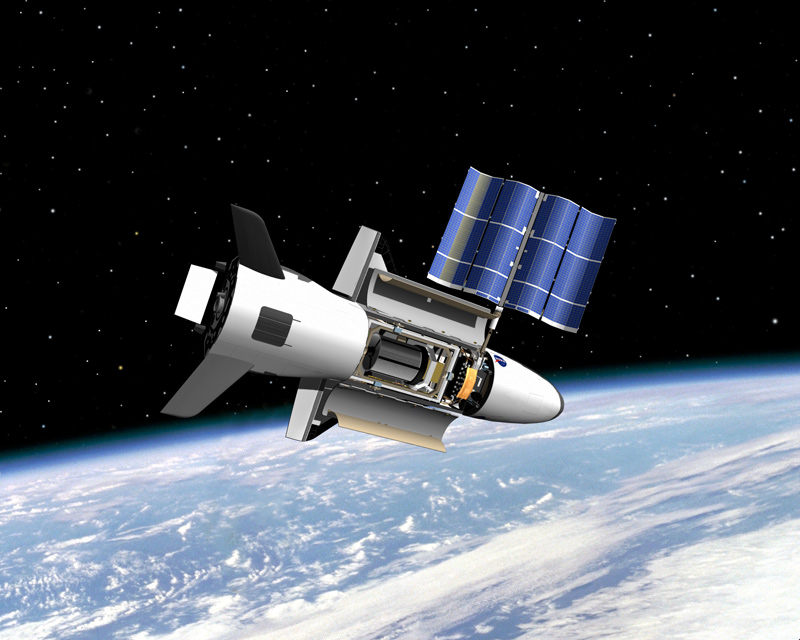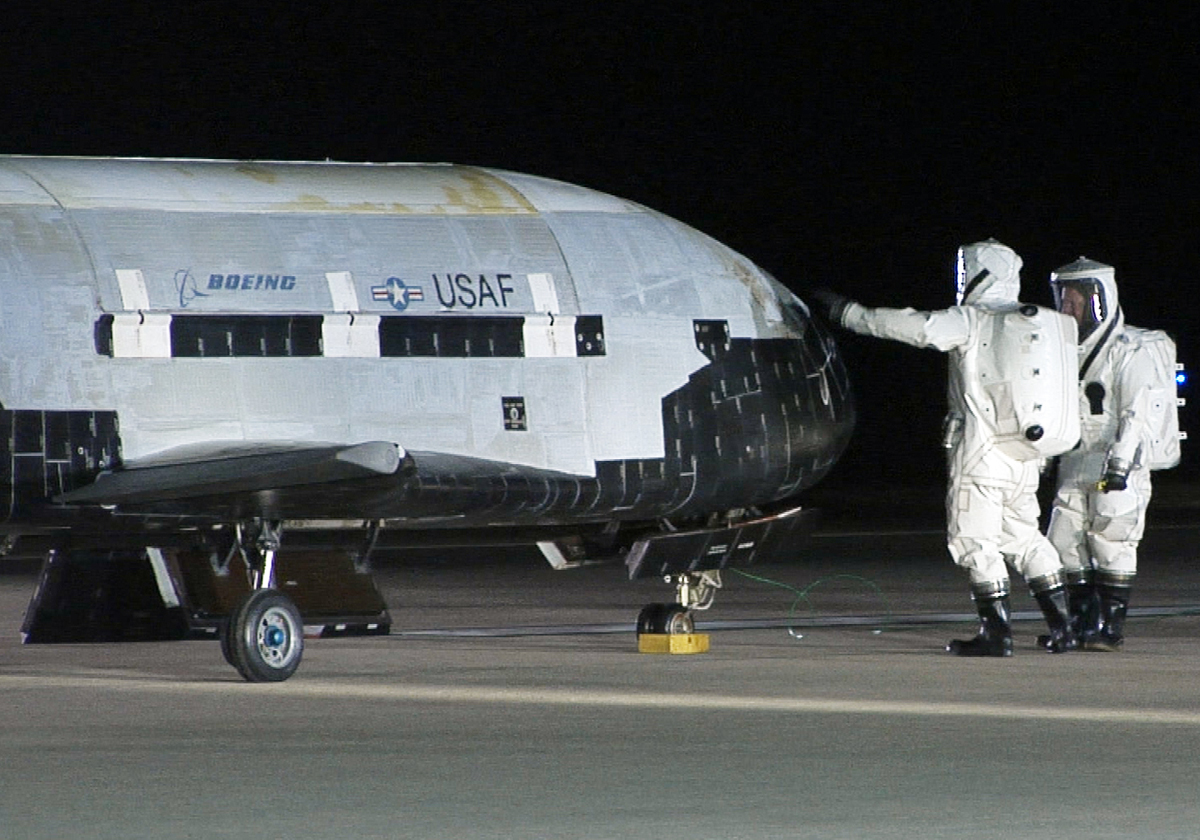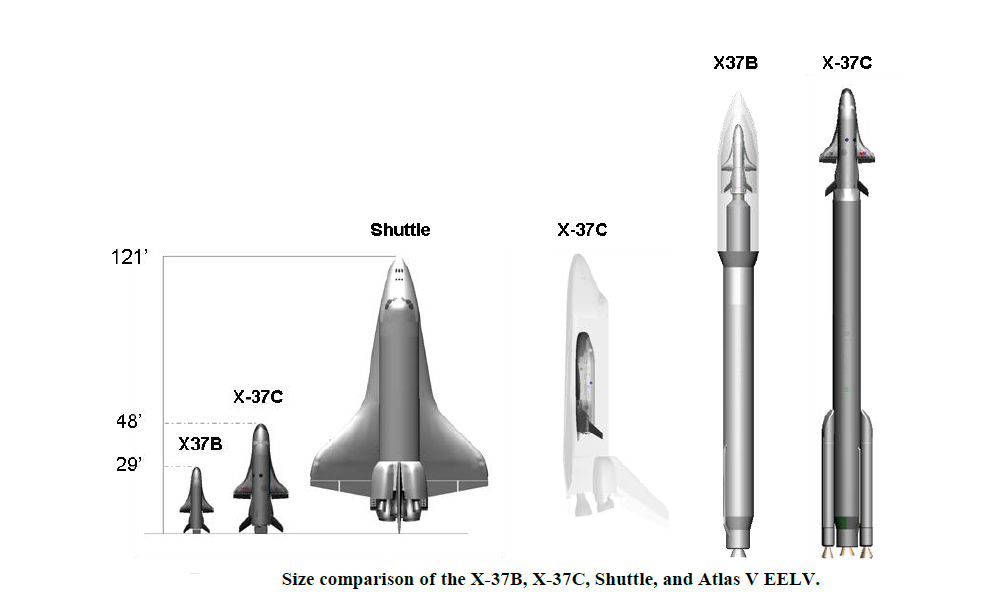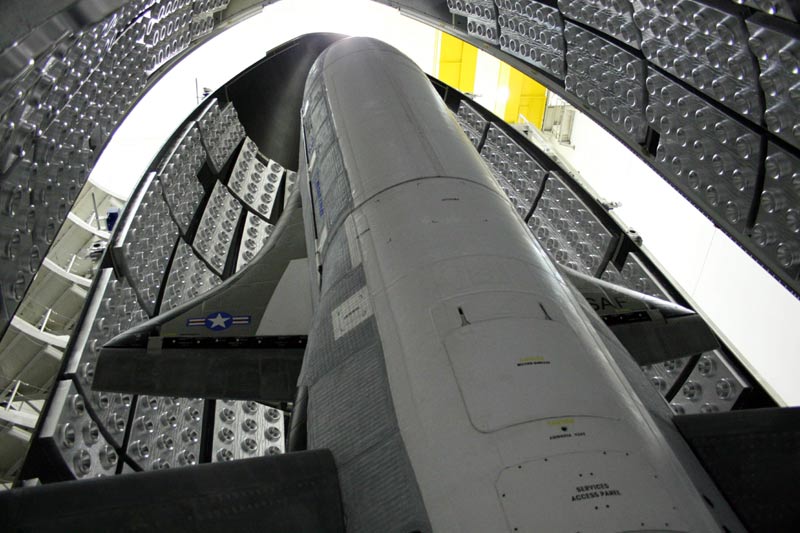
US Air Force's Secretive X-37B Space Plane Nears Day 500 in Orbit

The U.S. Air Force's mysterious robotic X-37B space plane is sailing toward the 500-day mark in Earth orbit on a secret military mission.
The X-37B space plane presently in orbit is carrying out the Orbital Test Vehicle 3 (OTV-3) mission, a classified spaceflight that marks the third long-duration flight for the unmanned Air Force spaceflight program. The miniature space shuttle launched on Dec. 11, 2012.
X-37B space planes launch into orbit atop an unmanned Atlas 5 rocket from a pad at the Cape Canaveral Air Force Station in Florida. The first two space-plane missions flew back to Earth on autopilot, each time touching down on a tarmac at the Vandenberg Air Force Base in California.
Earlier this year, the X-37B supplier Boeing Space & Intelligence Systems announced plans to consolidate space-plane operations by using NASA's Kennedy Space Center in Florida as a landing site for the space plane.
Intelligence-gathering space plane
An X-37B space plane is about one-fourth the size of a former NASA space shuttle and uses a deployable solar array for power. It weighs 11,000 lbs. (4,990 kilograms) and has a small payload bay about the size of the bed of a pickup truck.
Each X-37B spacecraft measures about 29 feet (8.8 meters) long and nearly 15 feet (4.5 m) wide, and has a payload bay that measures 7 feet (2.1 m) long and 4 feet (1.2 m) wide. The space plane can operate in orbits that fly between 110 miles (177 kilometers) and 500 miles (805 km) above the Earth.
Breaking space news, the latest updates on rocket launches, skywatching events and more!
The secret missions for X-37B space planes are carried out under the auspices of the Air Force Rapid Capabilities Office, and mission control for OTV flights are handled by the 3rd Space Experimentation Squadron at Schriever Air Force Base in Colorado.
This unit is billed as the Air Force Space Command's premier organization for space-based demonstrations, pathfinders and experiment testing, gathering information on objects high above Earth and carrying out other intelligence-gathering duties.
And that may be a signal as to what the robotic craft is doing — both looking down at Earth and upward.
X-37B and U.S. military space

Just how the trio of X-37B clandestine missions might fit into the military's strategic space plans is speculative. However, recent testimony before Congress of top U.S. military space brass underscores the overall fervor for "space control." [Space Weapons: Most Destructive Military Concepts]
Space control requires knowledge derived from satellite situational awareness to warn and assess threats that pose a risk to U.S. and coalition space operations, Lt. Gen. John Raymond, commander of the Joint Functional Component Command for Space, said before the House Armed Services Subcommittee on Strategic Forces earlier this month.
"Space control may also include threat avoidance, safeguarding of our on-orbit assets and the ability to mitigate electromagnetic interference," Raymond testified.
Decision to declassify
Some analysts believe that the space-plane missions could be flying sensor gear useful for a recently declassified activity, the Geosynchronous Space Situational Awareness Program (GSSAP).
GSSAP will deliver two satellites for a single launch that are headed for near geosynchronous orbit (GEO). From that vantage point, they will survey objects in the GEO belt to track both known objects and debris and to monitor potential threats that may be aimed at this critically important region.
"Our decision to declassify this program was simple: We need to monitor what happens 22,000 miles (35,000 km) above the Earth, and we want to make sure that everyone knows we can do so," testified Douglas Loverro, deputy assistant secretary of defense for space policy for the U.S. Department of Defense.
GSSAP satellites will communicate information through the worldwide Air Force Satellite Control Network ground stations, and then to Schriever Air Force Base, where the 50th Space Wing satellite operators will oversee day-to-day command and control operations.

A strategic crossroad
The commander of Air Force Space Command, Gen. William Shelton, also testified at the same April 3 hearing, telling lawmakers he believed "we are at a strategic crossroad in space."
Shelton, who first unveiled the once-classified GSSAP in February, said the two spacecraft expected to launch in 2014 will collect space situational awareness data, thus allowing for more accurate tracking and characterization of human-made orbiting objects in a near-geosynchronous orbit. [See amateur video of the X-37B space plane from March 4]
"Data from GSSAP will contribute to timely and accurate orbital predictions, enhance our knowledge of the geosynchronous environment and further enable spaceflight safety to include satellite collision avoidance," Shelton said.
More things to come
As an experimental spacecraft, the X-37B is a precursor of things to come, said Marshall Kaplan, a space consultant and principal at Launchspace Inc., a training group for space professionals based in Bethesda, Md.
"It gives a certain amount of flexibility that we haven't had before," given that the craft flies and lands without a crew, is able to be reused and can haul specialized payloads for certain types of surveillance and other types of missions related to national security, Kaplan said.
But given that the craft is lofted by an Atlas 5 rocket — an expensive boost — "what we really need now is a cheap booster … which we don't have," Kaplan told Space.com. "It's the missing element."
Kaplan said to keep an eye on the Defense Advanced Research Projects Agency's (DARPA) Experimental Spaceplane (XS-1) program. DARPA seeks to lower satellite launch costs by developing a cheap, reusable first stage that would fly to hypersonic speeds at a suborbital altitude, he said.
"In the big picture of things, these two programs [X-37B and XS-1] could come together at some point in the future and be operational," Kaplan said.

Fast follower
Whatever its utility, how an on-going X-37B program will play out in China is on the mind of Everett Dolman, professor of military strategy at the School of Advanced Air and Space Studies at Maxwell Air Force Base in Alabama.
One early indication is that China has purportedly pushed forward on its own "Shenlong" space plane planning.
"As far as the Shenlong is concerned, I am pretty much in agreement at this point that it is part of a broader 'fast follower' program similar to the Soviet Union's adaptive approach in the Cold War," Dolman told Space.com.
Just as the former Soviet Union felt a need to develop its own space shuttle — the remotely piloted Buran that only flew once — Dolman said "the Chinese probably are concerned about a sudden leap in technology or tactics that would give a decisive, if temporary, edge to the U.S. should it be unveiled at a critical moment."
"By keeping a close watch and matching what appears to be a high-priority technological capability, the fast follower spends less on research and development and can, hopefully, close the technology gap quickly," Dolman said.
It is a second-best strategy for long-term competition in business, Dolman said, adding that he's not sure it is even that for potential combat scenarios. "But the People's Republic of China obviously believes the U.S. is committed to the X-37B and doesn't want to be left tying its shoes in the gate when the starting-pistol sounds," he concluded.
Leonard David has been reporting on the space industry for more than five decades. He is former director of research for the National Commission on Space and is co-author of Buzz Aldrin's new book, "Mission to Mars – My Vision for Space Exploration," published by National Geographic. Follow us @Spacedotcom, Facebook and Google+. Original article on Space.com.
Join our Space Forums to keep talking space on the latest missions, night sky and more! And if you have a news tip, correction or comment, let us know at: community@space.com.

Leonard David is an award-winning space journalist who has been reporting on space activities for more than 50 years. Currently writing as Space.com's Space Insider Columnist among his other projects, Leonard has authored numerous books on space exploration, Mars missions and more, with his latest being "Moon Rush: The New Space Race" published in 2019 by National Geographic. He also wrote "Mars: Our Future on the Red Planet" released in 2016 by National Geographic. Leonard has served as a correspondent for SpaceNews, Scientific American and Aerospace America for the AIAA. He has received many awards, including the first Ordway Award for Sustained Excellence in Spaceflight History in 2015 at the AAS Wernher von Braun Memorial Symposium. You can find out Leonard's latest project at his website and on Twitter.
